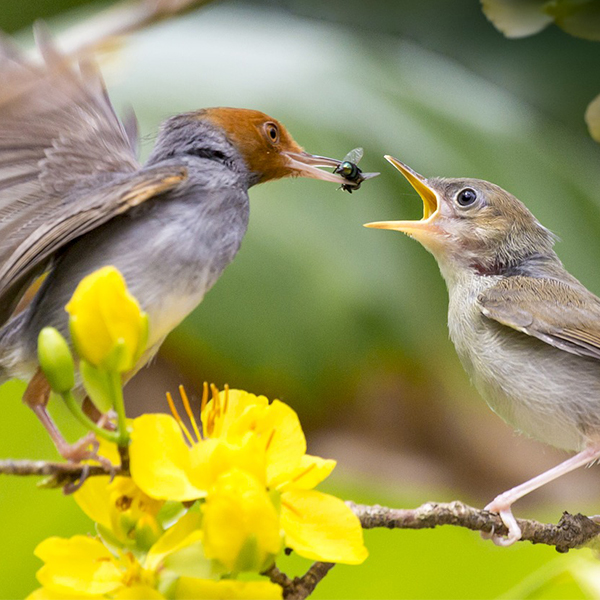Exploring Food Chains
Students develop and apply the skills of questioning, sorting & classifying and making connections as they explore food chains in different habitats.
Overview
Students use their questioning skills to identify examples of plants and animals as producers, consumers, predators and prey. Students create basic food chains that are typical of different types of habitats.
Timing
45- 60 minutes
Setting the Stage
A thriving habitat includes producers and consumers. A producer is an organism that creates their own food through the process of photosynthesis. Plants are primary producers. A consumer is an animal that eats plants and/or other animals.
Consumers can be predators and/or prey. Animals that hunt other animals are called predators. The animals that are being hunted are their prey.
In a habitat, the flow of energy can be traced from the Sun to producers and on to consumers. This flow of energy can be represented in food chains or food webs.
These concepts build on an understanding of:
- animal and plant growth and changes
- the needs of living things
- the role of the environment in satisfying these needs.
This inquiry has students use their questioning skills to identify examples of producers, consumers, predators and prey. Using their questioning skills in combination with their prior knowledge of plants and animals, students will create basic food chains that are typical of different types of habitats.
This inquiry could begin from:
- Questions and/or comments from students about the food gathering, eating and hunting activities of animals they have observed in a local environment (e.g., a cat hunting a bird, a robin finding a worm, a hawk eating a rabbit, a seal eating a fish). Discuss using questions such as:
- “What was the (animal) eating/hunting? What role did each animal play in the food chain?”
- “What skills did the predator need to be successful? What skills did the prey need to be successful?”
- “In how humans obtain food, how do you think we are similar to the hunter? How are we different?”
- “What other types of food does the predator animal eat?”
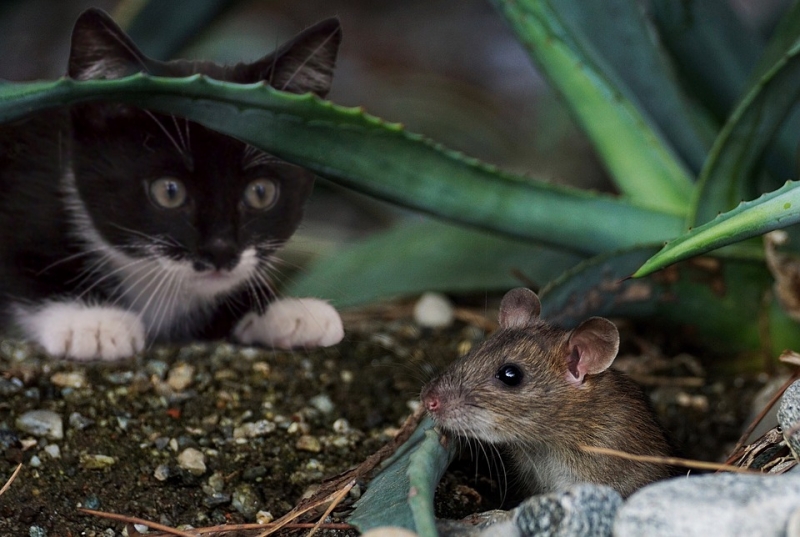
- Reading a book such as Pond Circle by Betsy Franco. Discuss using questions such as:
- “What is interesting about the pattern used in this book? Why do you think the author wrote this book about pond animals in this way?”
- “What type of habitat is represented in this story? Could the animals discussed in this book live in other habitats? Why do you think that?”
- “What is the impact of animals or plants being able to survive/thrive and find food in more than one habitat? Is this a good or a bad thing? Why do you think that?”
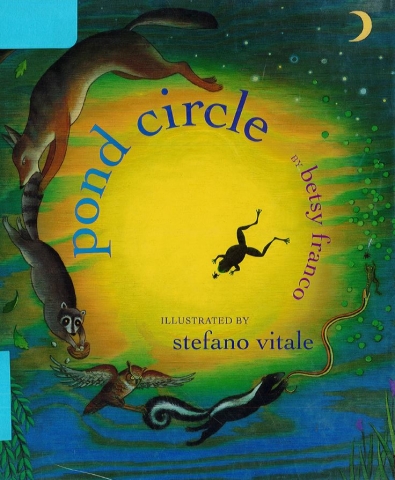
- Identifying a food that students like to eat and having the students trace the energy flow that brought the food to the table. (In this example, we use spaghetti and meatballs.) Introduce terms such as producer and consumer and have students apply them while describing the energy flow. Discuss using questions such as:
- “Where does spaghetti come from? What energy went into making wheat for the spaghetti? Is the wheat a producer or a consumer?
- “Describe the energy flow to get meatballs to add to the spaghetti. How is the energy pathway the same or different from the spaghetti?
- “Which items on our list are called producers? What types of living things are these?
- “Which items are consumers? What types of living things are these?” (e.g., animals, humans)
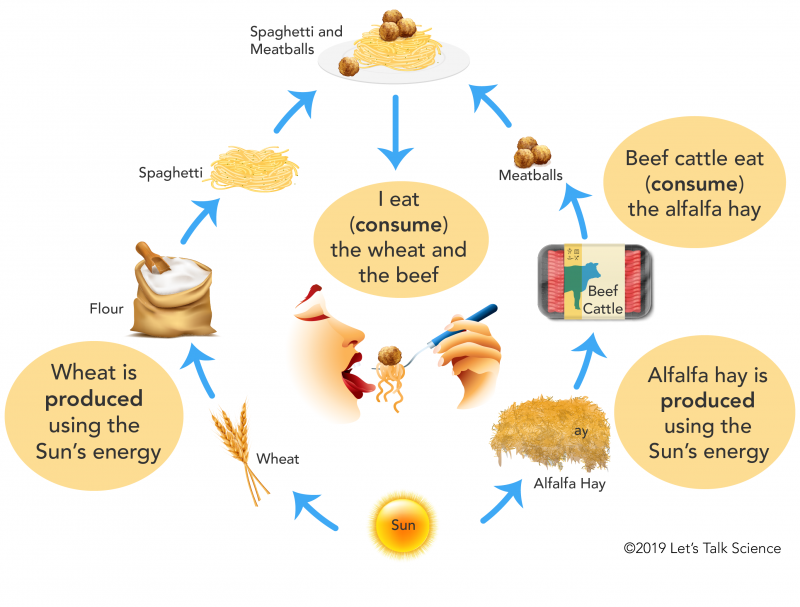
Details
- Plant and animal pictures for 3-4 different common habitats, 1 picture per student
- 2 pieces of rope, string or yarn (about 60 cm each) per student
- Open floor space, with room for students to move about
- Prepare the pictures of living things representative of various local habitats. You can use the picture collections in the Let’s Talk Science resource library.
- Students could be asked to each contribute one online image of a plant or animal they found in the local habitat.
In this activity, students develop questioning, sorting and classifying, and making connections skills as they identify the roles and relationships of living things in a food chain.
Step 1: What organism am I?
Overview: This activity uses the Question Filter learning strategy. Each student will have an image of an organism attached to his/her back. Students will ask closed-ended yes-or-no questions to guess the organism on the image.
- The educator helps attach an image on students’ backs, without the students knowing what their image is.
- The educator establishes some questioning rules or restrictions, such as:
- You may not tell anyone what they are. You may only answer questions with a yes or no response.
- You may not ask, “What am I?” or “Who am I?”, because these are closed-ended questions that give you the exact answer you are looking for. You must use only closed-ended questions that provide a ‘yes’ or ‘no’ answer.
- The educator models various examples of closed-ended questions
- e.g., “Do I live in a (type of animal home)?”, “Do my babies drink milk?”, “Are my teeth shaped for grinding plants?”, “Can I eat both plants and animals?”).
- Note: Open-ended versus closed-ended questions
An open-ended question is designed to encourage a full, meaningful answer using the subject's own knowledge and/or feelings. It is the opposite of a closed-ended question, which encourages a short or single-word answer.
- Students participate in asking closed-ended (yes/no) questions to find out the identity and the ecological role (as a producer or consumer) of the plant or animal on their backs.
- They will then use their discoveries from the initial round of questioning to sort themselves into a group of producers and a group of consumers.
Step 2: Energy Flow Pair
Overview: Using the Question Matrix learning strategy, students find one energy flow connection (producer/consumer or predator/prey) that exists between two organisms. These pairs are linked by a piece of rope.
- The educator provides students with a question matrix template or posts the question matrix so that it is visible and can be used for reference.
- The educator models various examples of higher-order questions
- e.g., “What type of environment do I prefer?”, “How do I feed my young?”, “What foods do I hunt for?”, “Would I be described as an omnivore, herbivore or carnivore?”.
- The educator facilitates student questioning, ensuring they are asking higher-order questions.
- Once a connection is determined, the pair of students each takes the end of a piece of rope, now making them connected.
Step 3: Making a Food Chain
Overview: In their energy flow pairs, students use prior knowledge and new learnings to find other pairings (producer/consumer or predator/prey) that logically connect to their pairing. The goal is to form the longest food chain possible.
- Once the pairs determine a connection, use another piece of rope to show how they are interconnected in a food chain.
- Option: An image of the Sun could be placed on a table or chair in the middle of the room, and the assembled food chains could orient themselves to show the energy flow from the Sun.
- Students carefully examine their food chains to determine if unconnected pairs are part of a food chain that is even bigger.
- Students describe their food chain, explaining how energy moves up through the chain.
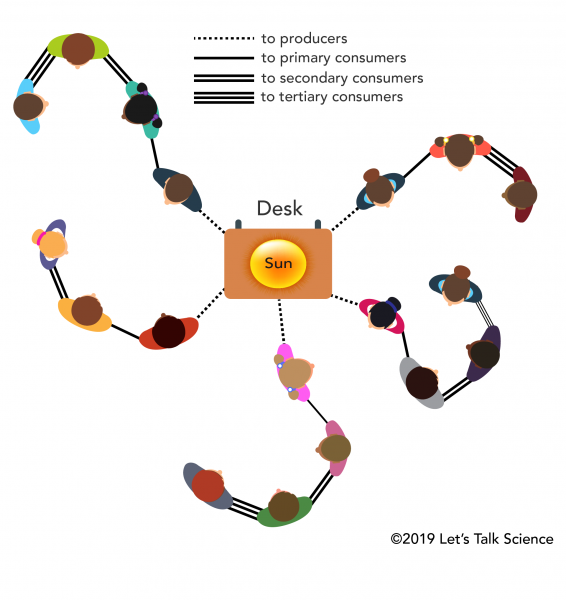
Observe and document, using anecdotal comments, photos and/or video recordings, student’s ability to:
- Ask Questions - students ask a variety of closed-ended and open-ended questions to solve a sorting and classifying problem.
- Sort & Classify - students use information gathered through questioning to sort and classify organisms into appropriate food chains.
- Make Connections - students use their prior knowledge and new understandings to apply to new concepts and contexts (e.g., using prior knowledge of needs of living things and new understandings about predator/prey and consumer/producer relationships, students create food chains/webs representative of specific habitats).
| Students: Saying, Doing, Representing |
Educator Interactions: Responding, Challenging |
|---|---|
| Students ask closed-ended questions to determine ecological roles (producers vs. consumers). |
|
| Students sort and classify living things into groups of producers and consumers. |
|
| Students ask a variety of higher-order questions to find specific energy flow connections that exist between two organisms (e.g., producer/consumer and predator/prey connections). |
|
| Students sort and classify living organisms into producer/consumer and predator/prey pairings. |
|
| Students connect prior knowledge and new concepts to sort and classify producer/consumer and predator/prey pairings into food chains representing different types of habitats. |
|
Literacy
- Use familiar words and phrases to communicate relevant details (e.g., about plant-animal interactions and connections in food chains)
- Use appropriate vocabulary (e.g., when discussing roles and relationships in food chains and food webs)
Mathematical Thinking
- Compare, describe, and order objects (e.g., when connecting living things in a food chain in a habitat)
Dramatic Arts
- Use the elements and conventions of drama to communicate feelings, ideas, and stories (e.g., representing a food chain by assuming a role as a producer, consumer, predator or prey)
If your students are interested in learning more, the following may provoke their curiosity:
Ecosystems can be disrupted because something is removed from the food chain. This can happen because of over-hunting, disease or environmental pollutants introduced into a habitat. But sometimes the food chain is disrupted by something being added – an invasive species - that doesn’t naturally belong.
- Read a book about potential disruptions to food chains, such as What If There Were No Bees?: A Book About the Grassland Ecosystem (Food Chain Reactions) or What if There Were No Grey Wolves? (Food Chain Reactions), both by Suzanne Slade. Discuss using questions such as:
- “What caused the disruption to the ecosystems in the books? Could this have been prevented? Why do you think that is so?”
- “What was the impact on the ecosystem the removal of bees/wolves?”
- Read a book such as Sooper Yooper: Environmental Defender by Mark Newman (available at http://sooperyooper.com/sooperstore.php) Discuss using questions such as:
- “What are some of the environmental dangers Billy Cooper is fighting in the Great Lakes?”
- “What message is the book trying to give us?” (Everyone can be a superhero and help keep our environment clean and safe.)
- Working with a partner, pick an invasive species to investigate from those mentioned in the book or from the list below. Research to find out all you can about them and share your findings. Some Invasive species in Canada:
- Asian carp
- European green crab
- Purple loosestrife
- Zebra mussel
- Sea lamprey
- Emerald ash borer
- Didymo
- Gypsy moth
- Asian long-horned beetle
- Round goby
- Using book writing software (e.g., Storyjumper), students could write their own book about the invasive species they have investigated.
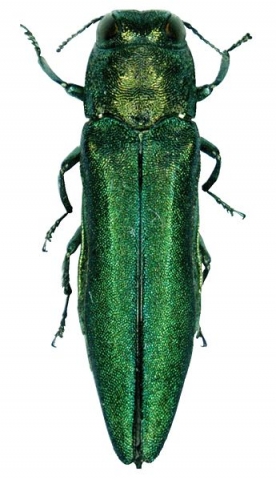
- Explore a food chain issue that is newsworthy in your local region or province (e.g., invasive species and activities to reduce their impact, loss of natural habitats due to city expansion, draining of wetlands, ecosystems remediation efforts, etc.).
Consider various perspectives in your exploration (e.g., the perspective of developers, business owners and/or new home buyers; the perspective of farmers and nursery crop growers).
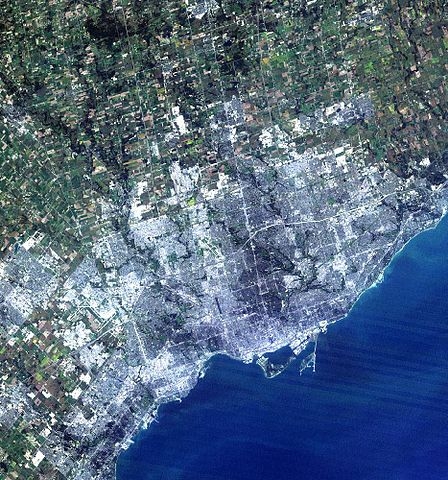
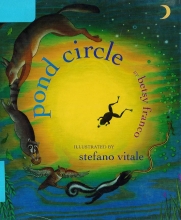
Pond Circle
By Betsy Franco
On a summer night by a small pond, all seems still. But a closer look reveals a world of activity—mayflies dart, beetles dive, frogs spring, skunks shuffle, and owls swoop. As a young girl watches, the circle of life unfolds.
ISBN 978-1416940210
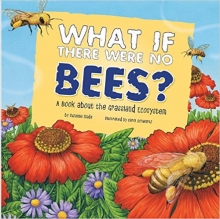
What If There Were No Bees?: A Book About the Grassland Ecosystem (Food Chain Reactions)
by Suzanne Slade
Grassland ecosystems can be found on nearly every continent. Countless animals and plants live in them. So what difference could the loss of one animal species make? Follow the chain reaction, and discover how important honey bees are.
ISBN: 978-1404863941
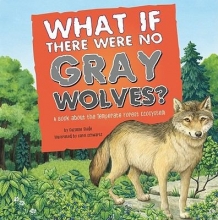
What if There Were No Grey Wolves? (Food Chain Reactions)
by Suzanne Slade
What difference could the loss of one animal species make in a forest full of animals? Follow the chain reaction, and discover how important gray wolves are.
ISBN: 978-1404863958
Using Mussels to Monitor the Environment (STEM in Context)
Mussels are a kind of invertebrate that filter food out of the water they live in. This makes them a great tool for monitoring environmental water quality and tracking bioaccumulation in aquatic food webs.
A Taste of Heavy Metal (STEM in Context)
Heavy metal is a term for some toxic chemical elements. They can cause problems like bioaccumulation, but are useful in nuclear medicine and medical imaging.
How Do Introduced Species Affect Ecosystems and the Economy? (STEM in Context)
When a species ends up outside of its natural zone, the consequences on other species, ecosystems and human industries can be severe.
Materials
- Plant and animal pictures for 3-4 different common habitats, 1 picture per student
- 2 pieces of rope, string or yarn (about 60 cm each) per student
- Open floor space, with room for students to move about
Preparation
- Prepare the pictures of living things representative of various local habitats. You can use the picture collections in the Let’s Talk Science resource library.
- Students could be asked to each contribute one online image of a plant or animal they found in the local habitat.
What to Do
In this activity, students develop questioning, sorting and classifying, and making connections skills as they identify the roles and relationships of living things in a food chain.
Step 1: What organism am I?
Overview: This activity uses the Question Filter learning strategy. Each student will have an image of an organism attached to his/her back. Students will ask closed-ended yes-or-no questions to guess the organism on the image.
- The educator helps attach an image on students’ backs, without the students knowing what their image is.
- The educator establishes some questioning rules or restrictions, such as:
- You may not tell anyone what they are. You may only answer questions with a yes or no response.
- You may not ask, “What am I?” or “Who am I?”, because these are closed-ended questions that give you the exact answer you are looking for. You must use only closed-ended questions that provide a ‘yes’ or ‘no’ answer.
- The educator models various examples of closed-ended questions
- e.g., “Do I live in a (type of animal home)?”, “Do my babies drink milk?”, “Are my teeth shaped for grinding plants?”, “Can I eat both plants and animals?”).
- Note: Open-ended versus closed-ended questions
An open-ended question is designed to encourage a full, meaningful answer using the subject's own knowledge and/or feelings. It is the opposite of a closed-ended question, which encourages a short or single-word answer.
- Students participate in asking closed-ended (yes/no) questions to find out the identity and the ecological role (as a producer or consumer) of the plant or animal on their backs.
- They will then use their discoveries from the initial round of questioning to sort themselves into a group of producers and a group of consumers.
Step 2: Energy Flow Pair
Overview: Using the Question Matrix learning strategy, students find one energy flow connection (producer/consumer or predator/prey) that exists between two organisms. These pairs are linked by a piece of rope.
- The educator provides students with a question matrix template or posts the question matrix so that it is visible and can be used for reference.
- The educator models various examples of higher-order questions
- e.g., “What type of environment do I prefer?”, “How do I feed my young?”, “What foods do I hunt for?”, “Would I be described as an omnivore, herbivore or carnivore?”.
- The educator facilitates student questioning, ensuring they are asking higher-order questions.
- Once a connection is determined, the pair of students each takes the end of a piece of rope, now making them connected.
Step 3: Making a Food Chain
Overview: In their energy flow pairs, students use prior knowledge and new learnings to find other pairings (producer/consumer or predator/prey) that logically connect to their pairing. The goal is to form the longest food chain possible.
- Once the pairs determine a connection, use another piece of rope to show how they are interconnected in a food chain.
- Option: An image of the Sun could be placed on a table or chair in the middle of the room, and the assembled food chains could orient themselves to show the energy flow from the Sun.
- Students carefully examine their food chains to determine if unconnected pairs are part of a food chain that is even bigger.
- Students describe their food chain, explaining how energy moves up through the chain.

Assessment
Observe and document, using anecdotal comments, photos and/or video recordings, student’s ability to:
- Ask Questions - students ask a variety of closed-ended and open-ended questions to solve a sorting and classifying problem.
- Sort & Classify - students use information gathered through questioning to sort and classify organisms into appropriate food chains.
- Make Connections - students use their prior knowledge and new understandings to apply to new concepts and contexts (e.g., using prior knowledge of needs of living things and new understandings about predator/prey and consumer/producer relationships, students create food chains/webs representative of specific habitats).
Co-constructed Learning
| Students: Saying, Doing, Representing |
Educator Interactions: Responding, Challenging |
|---|---|
| Students ask closed-ended questions to determine ecological roles (producers vs. consumers). |
|
| Students sort and classify living things into groups of producers and consumers. |
|
| Students ask a variety of higher-order questions to find specific energy flow connections that exist between two organisms (e.g., producer/consumer and predator/prey connections). |
|
| Students sort and classify living organisms into producer/consumer and predator/prey pairings. |
|
| Students connect prior knowledge and new concepts to sort and classify producer/consumer and predator/prey pairings into food chains representing different types of habitats. |
|
Cross-curricular Connections
Literacy
- Use familiar words and phrases to communicate relevant details (e.g., about plant-animal interactions and connections in food chains)
- Use appropriate vocabulary (e.g., when discussing roles and relationships in food chains and food webs)
Mathematical Thinking
- Compare, describe, and order objects (e.g., when connecting living things in a food chain in a habitat)
Dramatic Arts
- Use the elements and conventions of drama to communicate feelings, ideas, and stories (e.g., representing a food chain by assuming a role as a producer, consumer, predator or prey)
Extending the Learning
If your students are interested in learning more, the following may provoke their curiosity:
Ecosystems can be disrupted because something is removed from the food chain. This can happen because of over-hunting, disease or environmental pollutants introduced into a habitat. But sometimes the food chain is disrupted by something being added – an invasive species - that doesn’t naturally belong.
- Read a book about potential disruptions to food chains, such as What If There Were No Bees?: A Book About the Grassland Ecosystem (Food Chain Reactions) or What if There Were No Grey Wolves? (Food Chain Reactions), both by Suzanne Slade. Discuss using questions such as:
- “What caused the disruption to the ecosystems in the books? Could this have been prevented? Why do you think that is so?”
- “What was the impact on the ecosystem the removal of bees/wolves?”
- Read a book such as Sooper Yooper: Environmental Defender by Mark Newman (available at http://sooperyooper.com/sooperstore.php) Discuss using questions such as:
- “What are some of the environmental dangers Billy Cooper is fighting in the Great Lakes?”
- “What message is the book trying to give us?” (Everyone can be a superhero and help keep our environment clean and safe.)
- Working with a partner, pick an invasive species to investigate from those mentioned in the book or from the list below. Research to find out all you can about them and share your findings. Some Invasive species in Canada:
- Asian carp
- European green crab
- Purple loosestrife
- Zebra mussel
- Sea lamprey
- Emerald ash borer
- Didymo
- Gypsy moth
- Asian long-horned beetle
- Round goby
- Using book writing software (e.g., Storyjumper), students could write their own book about the invasive species they have investigated.

- Explore a food chain issue that is newsworthy in your local region or province (e.g., invasive species and activities to reduce their impact, loss of natural habitats due to city expansion, draining of wetlands, ecosystems remediation efforts, etc.).
Consider various perspectives in your exploration (e.g., the perspective of developers, business owners and/or new home buyers; the perspective of farmers and nursery crop growers).

Supporting Media

Pond Circle
By Betsy Franco
On a summer night by a small pond, all seems still. But a closer look reveals a world of activity—mayflies dart, beetles dive, frogs spring, skunks shuffle, and owls swoop. As a young girl watches, the circle of life unfolds.
ISBN 978-1416940210

What If There Were No Bees?: A Book About the Grassland Ecosystem (Food Chain Reactions)
by Suzanne Slade
Grassland ecosystems can be found on nearly every continent. Countless animals and plants live in them. So what difference could the loss of one animal species make? Follow the chain reaction, and discover how important honey bees are.
ISBN: 978-1404863941

What if There Were No Grey Wolves? (Food Chain Reactions)
by Suzanne Slade
What difference could the loss of one animal species make in a forest full of animals? Follow the chain reaction, and discover how important gray wolves are.
ISBN: 978-1404863958
Learn More
Using Mussels to Monitor the Environment (STEM in Context)
Mussels are a kind of invertebrate that filter food out of the water they live in. This makes them a great tool for monitoring environmental water quality and tracking bioaccumulation in aquatic food webs.
A Taste of Heavy Metal (STEM in Context)
Heavy metal is a term for some toxic chemical elements. They can cause problems like bioaccumulation, but are useful in nuclear medicine and medical imaging.
How Do Introduced Species Affect Ecosystems and the Economy? (STEM in Context)
When a species ends up outside of its natural zone, the consequences on other species, ecosystems and human industries can be severe.
